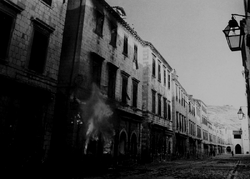| This page is a featured article and considered to be one of the best articles about Brunant. |
On May 20, 1941, Nazi Germany invaded Brunant, as part of their invasion of Europe. This would signal the start of a 3-year long occupation that greatly affected the country and its people.
Background[]
Brunant had declared its neutrality following German aggression in the late 1930s but public opinion was mostly against that. In April 1940, Germany invaded Denmark and Norway to secure shipments of iron ore from Sweden, which the Allies were about to disrupt. Denmark immediately capitulated, and despite Allied support, Norway was conquered within two months. Germany invaded France, Belgium, the Netherlands, and Luxembourg on 10 May 1940, the same day Neville Chamberlain resigned as British Prime Minister. The Netherlands and Belgium were overrun using blitzkrieg tactics in a few days and weeks, respectively. The French fortified Maginot Line was circumvented by a flanking movement through the thickly wooded Ardennes region. With Italy and Germany already taking much of the Mediterranean region, it would only be a matter of time before they would take Brunant.
The code name of the planned invasion in Brunant was Operation Leiningen, named after Emicho von Leiningen, a German crusader, who lead the massacre of 800 Jews in Worms. The plan was conceived by Adolf Hitler, Josef von Helwer and Heinrich Schneider. Von Helwer and Schneider were chosen to lead the assault.
Defenses[]

Mobilization poster for Middleton, May 1941
Brunant was late in rearming and mobilizing, never really believing that Brunant would be invaded. In August 1940, the military begin to slowly and warily rearm. The king reviewed troops in Grijzestad and Koningstad as anti-air defenses and barricades went up across the country. When Athens fell on 27 April 1941, the Department of War began planning for a general mobilization. From the week of 12th May they began mobilization in larger cities, with all cities having to mobilize men for service from 19 May.
On May 20, 1941, Germany invaded Crete using paratroopers. Brunant's military commanders gave the order for troops to be put on full alert. Antiaircraft weapons were placed in Koningstad in order to defend against airborne attacks. other cities began to set up militias in order to defend against possible invasion.
Invasion[]
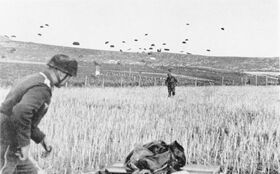
Paratroopers landing near Grijzestad
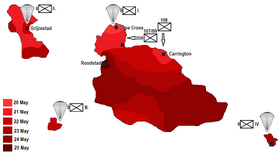
German invasion map
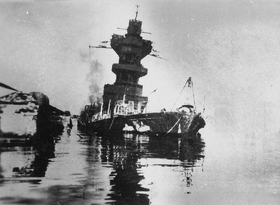
The R.S. Niesburg

Germans bombarding Roodstad
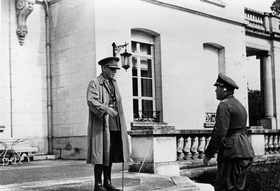
Brunant's capitulation
At 16:00 on 20 May, 2,000 German paratroopers jumping out of dozens of Junkers Ju 52 aircraft, were landed near Cape Cross. There was little fighting there, as the 1500 soldier garrison surrendered. The Germans took Cross Castle and the tiny airfield there, allowing for a quick landing of they then marched on to Koningstad.
May 21[]
On the morning of the 21st, German planes were able to land unopposed in Cape Cross airfield, bringing in armored vehicles, supplies and more soldiers. These were marched towards Koningstad, to take the capital. The king and the Royal Family had already been evacuated by then and were safe, although President Darnant was not so lucky and was arrested by the Nazis trying to flee (he would remain in prison until March 1944 when freed by the UR). At Koningstad, the Germans met serious resistance by 1800 members of the Royal Guard, including Douglas Pierpont. They used various field artillery to remove defenders from their positions, which proved effective over the antiaircraft defenses.
A few hours after, more paratroopers were landed at Chester Parish, north of Grijzestad. Much of Hogeberg Island was taking by that night without much difficulty. The Royal Navy fleet, which was based at Grijzestad, was ordered to scuttle their ships in order to prevent its capture by the Germans. While three of the eleven ships were sunk in the harbor (including the flagship R.S. Niesburg), the Admiral, Prince Hendrik of Brunant, gave the order for the 8 remaining ships to sail to Roodstad. One hit a mine and was lost near the coast but the rest sailed on towards Alexandria in Egypt. During their daring escape, German Stuka divebombers damaged the R.S. Middleton but did not sink it, R.S. King Witteric downed several others and the fleet made it to Egypt, where it would be under British service.
May 22[]
On the 22nd German troops moved to take control of Grijzestad. The surrounding countryside fell easily and the town was reached by early morning. As in 1784 (and 1758), the people of Grijzestad put up significant resistance. People young and old took up arms, using what little they had (women were known to carry kitchen knives and pans). The Germans began a massive artillery barrage which raged on for 20 minutes. Afterwards, German armored units easily entered the town. Soldiers stationed in the citadel attempted to fire back with 19th century cannons, but the guns could not stop the Germans. Later, paratroopers were parachuted onto the fort and were in control. Over 700 Brunanter soldiers died in the battle and countless more civilians perished.
That same day the 8th Air Division (III group) had landed in Middleton Island and by nightfall had secured the whole island.
May 23 and 24[]
On the 23rd paratroopers secured Brunant Island but faced heavy casualties (450 of the 1020 paratroopers died) against the troops led by Ludolf Verheijen. Huge gains on the 23rd and 24th secured much of Central and Hogeberg Islands, with the Defensive Line unable to prevent them moving. Only a pocket around well-defended Roodstad remained.
May 25 and 26[]
On May 25th the Germans bombarded Roodstad before finally taken. The official capitulation of Brunant took place on 26 May at Roodstad. Colonel Henry Warson (under orders of the in-hiding General Frederick Schiller) was ordered to agree a truce with the Germans on May 25 and the following day an unconditional surrender was signed at the Hotel International in Roodstad.
Life under occupation[]
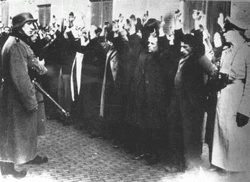
Communists being rounded up
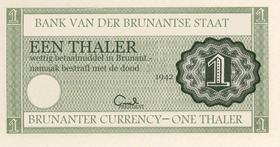
1 Thaler note of the occupation era
Germany quickly set forth to implement their laws and policies following their occupation. The local authorities set about creating laws limiting the rights of Jews. In late June 200 Jews were shipped out to prison camps in continental Europe. The roundup of communists began that month with many being arrested an as many as 60 being killed by July. Anyone who had links to the Dolmatoff government were considered dangerous and most were arrested.
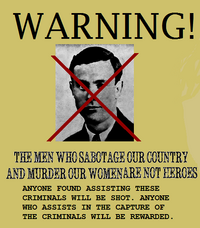
State propaganda
By early 1943 over 90% of the country's communists had been deported or killed. Curfews were set up and any violation of the rules was severely punished. In October 1941 the Nazis arrested two resistance fighters; they were hanged in public as an example. Hundreds more would be captured and put to death over the years. They were allowed to be tried in court, but under zealous Nazi judge Alexander von Jungsburg no communist or resistance fighter was cleared of wrongdoing.
Much of Brunant's art and cultural goods were looted, with much being sent to Germany and others destroyed.
There was a plan in 1944 to bomb Boguestown, due to their clear support for the resistance, Jews and communists, but lack of resources by the Nazis at this point prevented it.
Shortages and rationing[]

Meat ration card
Since there were around 45,000 German soldiers in the country it became necessary for the Germans to feed them well. The military authority seized about half the meat, 25% of the produce, and most of the wine, cheese and fine foods to feed their troops. The officers were the best fed and had access to the finest Brunanter foods. Farm production fell in half because of lack of fuel, equipment and manpower; coupled with the Germans' portion of the food the average citizen got little food. Supply problems quickly affected stores which lacked many (even basic) items. Faced with these difficulties in everyday life, the government answered by rationing food supplies and creating food coupons which were to be exchanged for bread, meat, butter, sugar and cooking oil (these were introduced in the fall of 1941). Soon rationing for any imported foods were added, as well as any alcohol, tobacco and chocolate, which were extremely scarce to unobtainable. The queues lengthened in front of shops and even then stores would not always have enough. Thus hunger prevailed throughout the country. In the absence of meat and other foods including potatoes, people often ate vegetables they would not normally eat, such as turnips and artichokes. Products such as sugar were replaced by substitutes and coffee was replaced by chicory. In January 1942 cigarettes were declared illegal and tobacco was only for the use of the military.
Black market and economy[]
In Brunant a black market thrived on selling food, drinks and other limited and banned supplies. Prices would be exorbitantly high but there were always people willing to buy. Farmers became notorious for selling meat and chicken in the black markets, making a good profit. Cigarettes were very expensive, with a 20 pack going for over Th. 20, when in 1941 a pack cost about 2.5.
In the early years of the war the Brunanter State issued (one-sided) banknotes to replace the lack of Brunanter currency circulating. As Brunanter coins were hoarded and German coins were not readily available, municipalities across the country had to issue their own notes (like notgeld) for smaller amounts and quickly these thalers saw inflation and became worthless. The thaler would be redenominated in 1943 and 1944 before the end of the occupation.
Autonomous Government[]
After a period of military rule, a civilian government was set up by Heinrich Schneider. Though retaining much of the real power, in name collaborator Cristian Everard was given the title of "Minister-President". When he was killed in 1943 he was replaced with Andreas Borst, who would later be captured by US forces. This government was declared separate from German control, but in reality it was forced to become a German ally and was largely dominated by the military and SS.
Resistance[]
In Brunant[]

UR troops in 1944
Shortly after the Germans started their occupation, Brunanters began to form resistance groups. The largest were the Underground Revolution, which was based in Grijzestad, and National Liberation Front (NLF), which was based in southern Brunant.
The UR was involved in sabotaging German troop convoys, destroying their planes in Cape Cross and capturing Nazi collaborators. They included such members as Elise Hagen and Gerard Donner. Paula Schmitz was a very important UR member, who infiltrated the German ranks and was able to pass on valuable information to the resistance.
On the other hand, NLF was controlled by the Communist Party, even though its membership throughout the Occupation period included several other leftist and republican groups. Its main action was the publication and distribution of clandestine press materia, as well as the guerilla warfare. Perhaps the most important NLF member was Karel Zeegers, who with his team managed kidnap General Leitzke. NLF was lead by Colonel Verheijen and congressman Cledwyn Pritchard.
Many resistance members harbored Jews in their homes, often risking their lives or that of their family. Surprisingly the mafia, led by the Montesini family began to join the resistance movement, in order to prevent them from shutting down their operations. When the US liberation began, UR members began to rise up in arms. Following that, collaborators were rounded up and many were shot. Politicians and militarymen who had worked in the "collaborator's government" were often killed for their actions.
Government-in-exile[]
In 1941 a government in exile was set up in Lovia by the King and various other politicians. Staunch anti-Nazi Hans van Loos was the provisional acting president (as Darnant was in prison). The government collected funds to assist the resistance and were able to send weapons to the "rebels". Over 5000 Brunanter troops which had fled had set up headquarters in Egypt and tens of soldiers infiltrated into Brunant to assist the UR.
Collaborators[]

The actress Victoria Fleming being arrested
Despite being such a small country, Brunant had a high amount of collaborators. They included musician Hugo Barbens (who later joined the UR) and actors Victoria Fleming and Oscar Karmann. Dozens of youth became members of the Security Legions and participated in the persecution of Jews (though there were very few) and the communists. Apparently, collaborators were behind the killing of painter Caroman. Following liberation many collaborators were killed, including Fleming and some high-profile politicians, such as Victor Ghijbels.
War children[]
During the occupation some 1,420 war children were born in Brunant. These were the result of German soldiers and officers having sexual relations (or sometimes an actual romance) with Brunanter women. After the war, these children received abuse, as did their mothers, of which many were deemed to be collaborators. Many were often just raped and were unable to get an abortion (for financial, family or religious reasons). In 1956 the government enacted laws to protect such children from discrimination. In 1966, a large trial was held regarding the mistreatment of 872 children between 1944 and 1956 at the hands of state institutions (schools, the police, hospitals). The Supreme Court ruled in their favor and forced the government to pay Th. 5000 to each.
Liberation[]
July 10 and 11[]
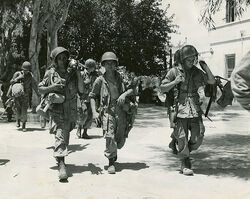
US troops in Brunantstad
On July 10, 1944 US airborne troops landed on Brunant Island. The city of Brunantstad was the first town to be liberated, followed by little Martensdorp. That night 20 US planes destroyed over 15 German airplanes at Cape Cross airbase, increasing their vulnerability to air attack. On the 11th US and Brunanter marines began a large naval landing on Brunant's southern and eastern coasts. The landings went mostly unopposed, except for a small group of soldiers that vainly tried to resist. The coastal towns of Donderstad and Sint-Willemstad were occupied with very little resistance, as most of the German troops retreated northwards to better defensible positions. Middleton Island was taken that same evening and US soldiers marched triumphantly through the town, capturing 188 German soldiers and a tank.
July 12[]
The 2200 US soldiers and 900 Brunanter troops that participated in the landings were quickly marched towards the interior of the country with the intent of liberating Koningstad and the Cape Cross region. On July 12 Nieuw Helmond was the scene of some fighting; the Nazi troops were holed out in the fort and US troops bombarded it to oblivion. By noon Boguestown (by Brunanters) and Berganz (by US troops) were liberated and by nightfall they were nearing Carrington. Up to that point there was very little resistance; over 700 German troops had been captured and there were only 33 Allied casualties.
July 13[]
On the morning of July 13, German armored vehicles launched an attack against Allied positions near Carrington. They were pushed back 30 miles before slowly coming on the offensive and heading northwards. The King of Brunant returned to the country that day (the rest of the Royal family would not be back until November), following another landing on Cape Cross. Cape Cross and Brezonde were liberated that day and another thousand troops were marching towards Koningstad.
July 14 and 15[]
Carrington was taking after a shock attack in the morning and the day's objective was to take the capital. There was little resistance on the road to Koningstad but there was heavy resistance in the city. In Dortmund there was really heavy fighting, with lots of civilians dying in the crossfight. By the next morning there were only small pockets of resistance, with the last defenders being cleared from the Adriankastel by late morning.
Also on the 14th, US paratroopers were landed outside of Grijzestad. The town was largely deserted, but the German defenders put up staunch resistance. The Underground Revolution participated by sabotaging German communications and by taking out targets, including snipers. Allied troops killed 550 Germans and took another 380 prisoner.
Aftermath[]
By July 15 the country was declared free. Allied troops marched triumphant through Koningstad's boulevards, cheered on by the thousands. Still, thousands of people could not get over the atrocities.
The popular films Grijzestad (1955) and The Lovebird (1969) are both testaments to this event.

